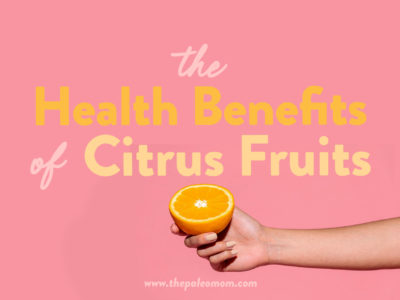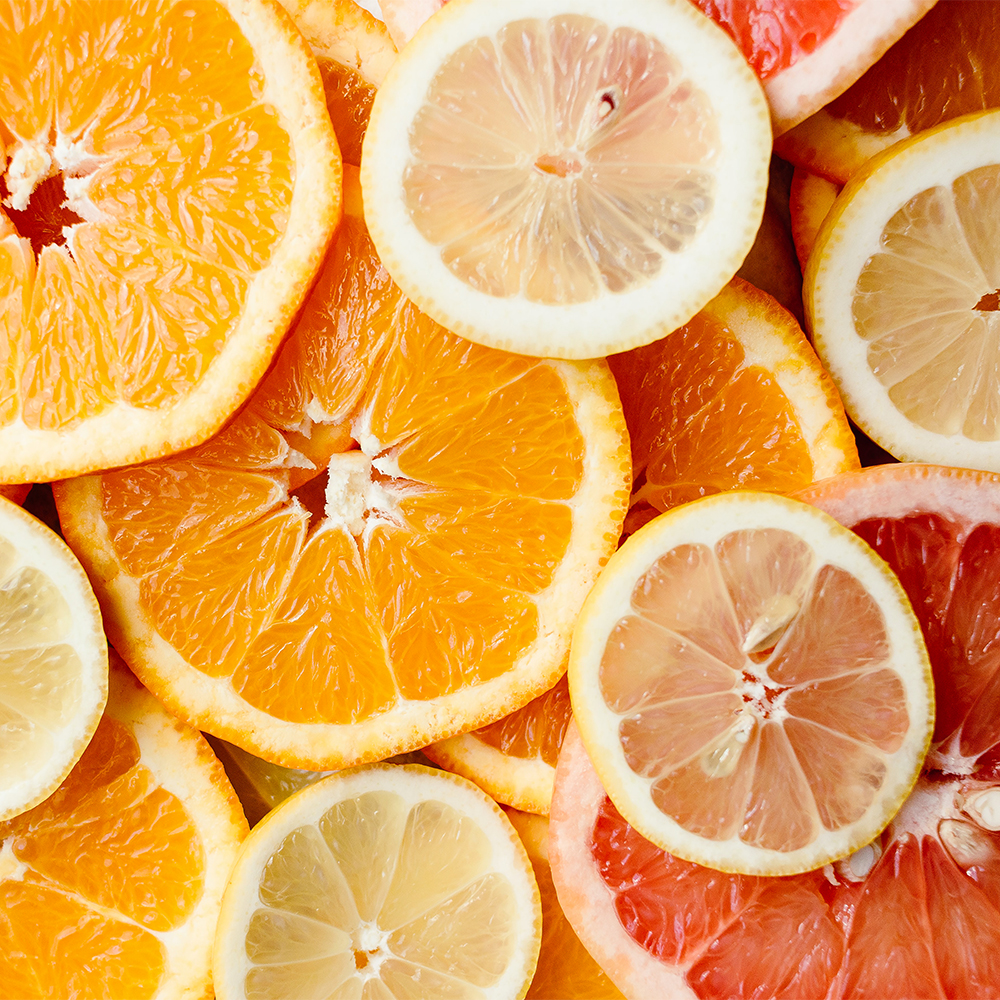 A juicy orange, a flavorful grapefruit, a sweet tangerine… the citrus family provides us with some of our most well-loved fruits! And along with being delicious, their impressive health benefits make them absolutely worth including in our diets. See also Why Fruit is a Good Source of Carbohydrates
A juicy orange, a flavorful grapefruit, a sweet tangerine… the citrus family provides us with some of our most well-loved fruits! And along with being delicious, their impressive health benefits make them absolutely worth including in our diets. See also Why Fruit is a Good Source of Carbohydrates
The citrus family includes the familiar oranges (there are over 600 different kinds!), grapefruit, limes, lemons, and tangerines, but also some lesser-known members such as ugli fruit, yuzu, kumquat, citron, bergamots, Buddha’s hand, and pomelos. Many of these fruits aren’t separate species, but hybrids of other existing citrus fruits (for example, grapefruits are actually a hybrid of the pomelo and sweet orange, and tangelos are a hybrid of either mandarin oranges or tangerines and grapefruit!). Like kiwis, citrus fruits are technically a type of berry. And despite their popularity today, citrus wasn’t always so abundant: lemons were once so rare that they were given to kings as gifts!
Health Benefits of Citrus Consumption
Not surprisingly, citrus consumption routinely shows up as health-protective in studies. A systematic review and meta-analysis of 95 studies found that citrus is significantly associated with lower risk of cardiovascular disease and mortality: high (versus low) citrus consumption reduced the risk of ischemic stroke by 22%, of hemorrhagic stroke by 26%, of cardiovascular disease by 22%, and of all-cause mortality by 10%. Among 28,000 participants from the Women’s Health Study, oranges were associated with a reduced risk of hypertension. A study of 10,623 Japanese adults with no history of cardiovascular disease found that near-daily intake of citrus fruit (compared with infrequent intake of citrus fruit) was associated with a 43% reduced risk of cardiovascular disease in men and 49% reduced risk in women. Another study found that a single serving of red grapefruit each day was able to lower LDL cholesterol by 20.3% and triglycerides by 27% among adults with heart disease. (White grapefruit had a more modest, but still significant, impact on those measurements.)
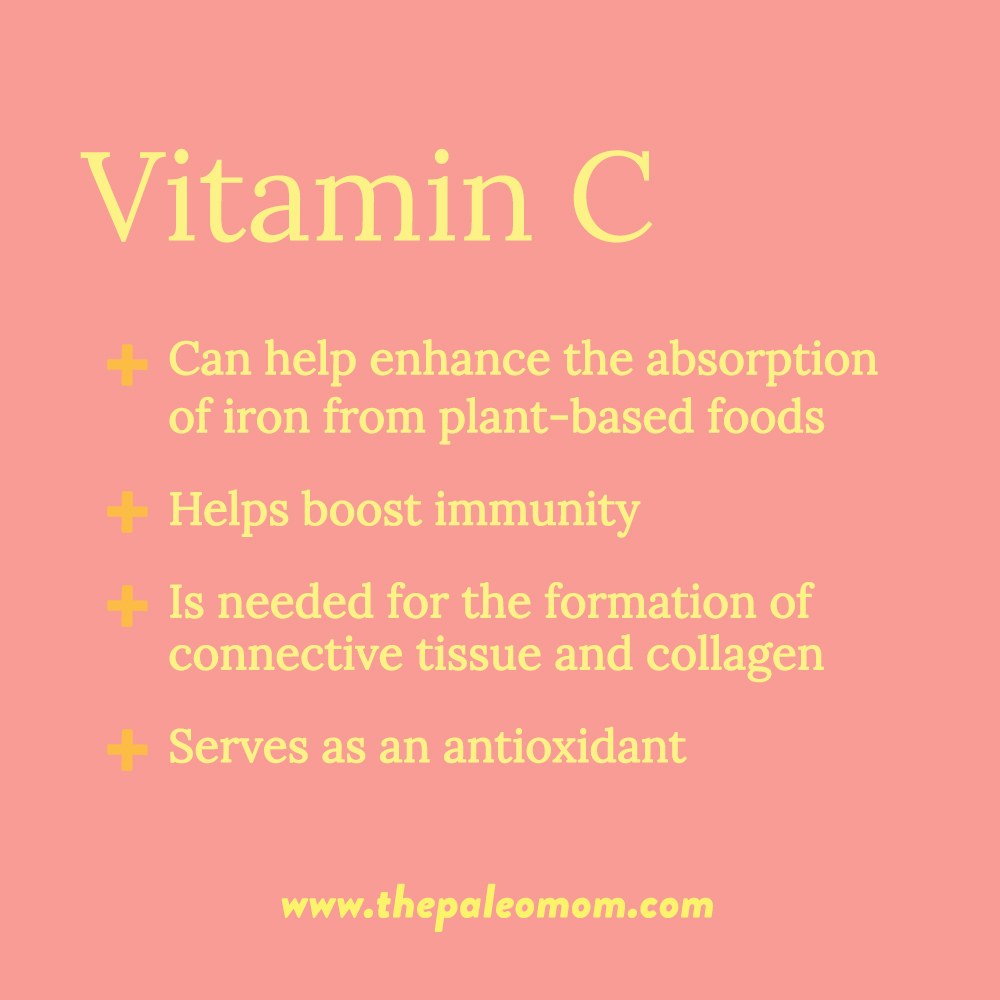 Citrus Fruits are Nutrient-Dense
Citrus Fruits are Nutrient-Dense
No matter what citrus fruit we look at, we’re sure to find some impressive nutritional features. Citrus confers unique benefits due to its high concentration of vitamin C, fiber, and phytochemicals (especially monoterpenes, limonoids, carotenoids, and the flavanones hesperidin and naringin). And across the board, citrus fruits are nutrient dense but not energy dense—meaning they deliver plenty of micronutrients but not a lot of calories!
The famously high vitamin C content of citrus comes with its own health perks. Vitamin C can help enhance the absorption of iron from plant-based foods (so go ahead and add some orange slices to that spinach salad!), helps boost immunity, is needed for the formation of connective tissue and collagen, and serves as an antioxidant.
Citrus fruits also contain:
- vitamin B1, which is needed for glucose metabolism and plays a role in the function of muscle tissue, nerves, and the heart;
- vitamin B2, which helps the body break down macronutrients and convert carbohydrates into ATP;
- vitamin B3, which plays an important role in metabolism;
- vitamin B6, which is involved in producing the neurotransmitters norepinephrine and serotonin;
- vitamin B9, which is needed to make blood cells and genetic material;
- potassium, which helps the body maintain fluid homeostasis;
- calcium, which is needed for healthy teeth and skeletal tissue;
- copper, which helps form red blood cells; and
- magnesium, which plays a role in muscle contraction.
They’re also impressive sources of dietary fiber! For example, a medium orange contains about 60 calories and 3 grams of fiber; a grapefruit has less than 80 calories and 2.5 grams of fiber; and a tangerine has less than 40 calories and 1.7 grams of fiber. Likewise, lemons and limes provide very few calories (but a whole lot of vitamin C) in the quantities in which we typically ingest their juice.
We can also maximize our nutrition intake from citrus by how we store these fruits. There’s some evidence that storing citrus at temperatures greater than 5°C (about 41°F) for long periods of time increases their loss of vitamin C, so either eating our fruit very fresh our storing it in very cool temperatures may be a good idea.
Citrus Phytochemicals: Limonoids, Hesperidin and Naringin
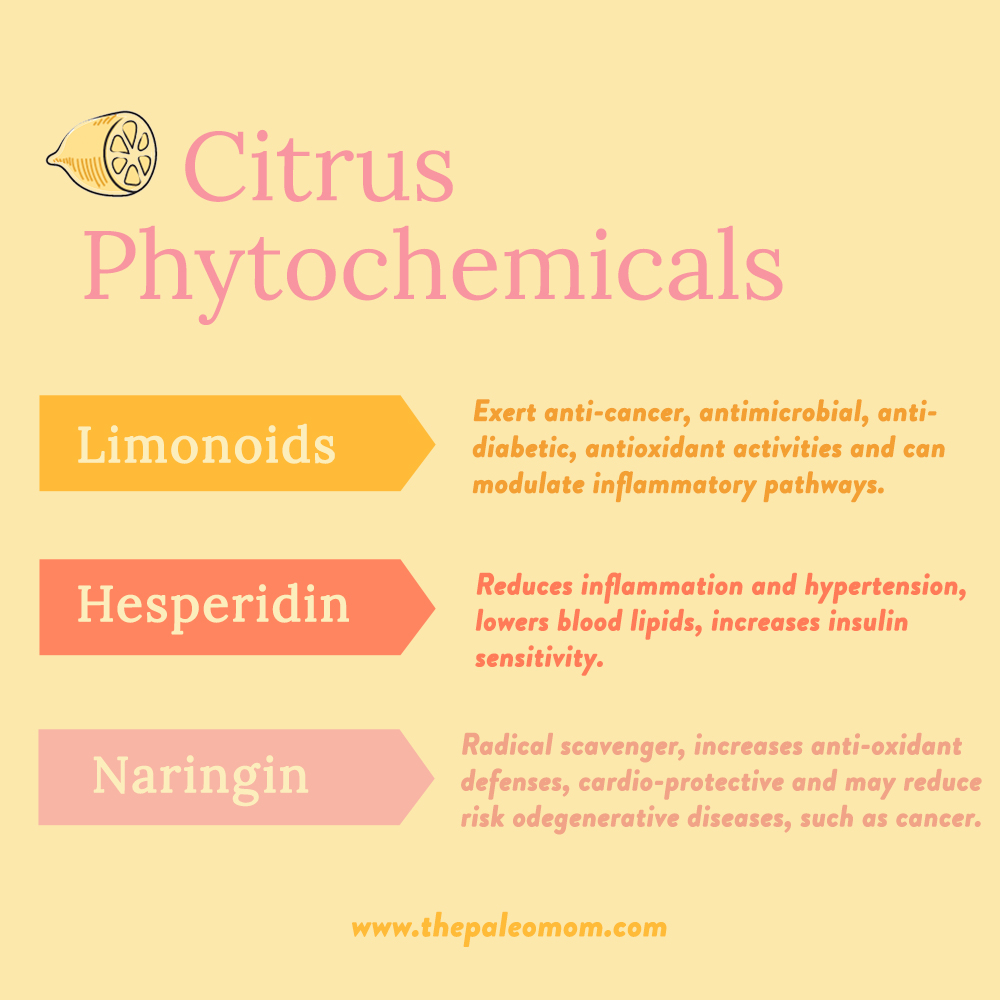 Numerous components of citrus fruit help explain their health-protective effects! Limonoids, in particular, have been extensively studied, and include limonin, obacunone, nomilin, and deacetylnomilin. These phytochemicals exert anti-cancer, antimicrobial, anti-diabetic, and antioxidant activities, all of which help explain the protective effects that show up in observational studies of citrus consumption. Limonoids have demonstrated antiproliferative activity against human cells (including liver cancer, meningioma, leukemia, lymphoma, pancreatic cancer, breast cancer, and colon cancer cells), and some research has shown that limonoids combined with curcumin from turmeric have an additive effect that makes this duo particularly powerful in fighting colon cancer (for more on curcumin, see Turmeric: The Full Scoop).
Numerous components of citrus fruit help explain their health-protective effects! Limonoids, in particular, have been extensively studied, and include limonin, obacunone, nomilin, and deacetylnomilin. These phytochemicals exert anti-cancer, antimicrobial, anti-diabetic, and antioxidant activities, all of which help explain the protective effects that show up in observational studies of citrus consumption. Limonoids have demonstrated antiproliferative activity against human cells (including liver cancer, meningioma, leukemia, lymphoma, pancreatic cancer, breast cancer, and colon cancer cells), and some research has shown that limonoids combined with curcumin from turmeric have an additive effect that makes this duo particularly powerful in fighting colon cancer (for more on curcumin, see Turmeric: The Full Scoop).
And it doesn’t end there! Citrus limonoids can modulate inflammatory pathways, and some limonoids have been shown to decrease circulating biomarkers of chronic inflammatory conditions (such as cardiovascular disease, diabetes, cancer, and nonalcoholic fatty liver disease). For instance, limonoids decrease circulating levels of the liver enzymes γ-glutamyl transferase, alanine aminotransferase, and alkaline phosphatase, as well as blood levels of the proinflammatory markers TNF-α, complement C3, and matrix metallopeptidase 9 (MMP-9).
The citrus phytochemicals hesperidin and naringin (along with their aglycones) are also winners for our health! Hesperidin is the main flavanone in sweet oranges, and naringin is what gives grapefruit its bitter taste. Although more research in humans is needed, studies suggest these phytochemicals are powerfully cardio-protective and may also reduce risk of other degenerative diseases, such as cancer. These compounds have been shown to reduce inflammation, reduce hypertension, lower blood lipids, increase insulin sensitivity, and exert antioxidant activity; naringin may likewise enhance ethanol metabolism, increase bone cell activity, stimulate DNA repair in prostate cancer cells, and act as an anti-apoptotic agent. Studies of naringin have shown its antioxidant effect is due to reducing reactive oxygen species and increasing antioxidant defenses, including catalase, glutathione peroxidase, and superoxide dismutase. Meanwhile, hesperidin acts as an antioxidant not only through radical scavenging, but also due to enhancing cellular antioxidant defenses, and has been shown to protect against oxidative stress from high fat diet-induced high blood sugar. (Additional citrus phytochemicals have antioxidant capacity, too, including the flavonoids nobitetin, rutin, and tangeretin.) Naringin has also been shown to protect against kidney toxicity induced by the antibiotic vancomycin, which is used to treat severe infections. In addition, naringenin, the aglycone of naringin, has been shown to inhibit the growth of some pathogens such as E. coli, Staphylococcus aureus, and Salmonella typhimurium.
Nutrivore Weekly Serving Matrix
An easy-to-use and flexible weekly checklist
to help you maximize nutrient-density.
The Weekly Serving Matrix is very helpful! I’ve been eating along these lines but this really helps me know where to focus vs. which foods serve a more secondary role. It’s super helpful and has taken a lot of worry out of my meal planning. Thanks!
Jan
Indeed, the phytochemicals in citrus can selectively kill certain pathogens! Orange pulp and peel in general have been shown to suppress the growth of Escherichia coli O157:H7 and Salmonella typhimurium, and the limonoid obacunone in particular has been shown to repress pathogenic forms of Salmonella. Given that citrus fruits produce phytochemicals in part to ward off insects and other pests, it’s not too surprising that their antimicrobial activity can have benefits for us as well!
And when it comes to different types of citrus? The more, the merrier! Although they share plenty of things in common, citrus fruits all have unique nutritional profiles, with some bioactive compounds being specific to certain fruits. For example,
- limes are rich in kaempferol, quercetin, and limonoids;
- oranges contain lutein, zeaxanthin, and hesperidin;
- grapefruits contain naringin, narirutin, and lycopene;
- lemons contain hesperidin and hesperetin; and
- tangerines are rich in tangeretin.
For that reason, getting a variety into our diet helps us get everything these fruits have to offer!
Benefits of Citrus Fiber
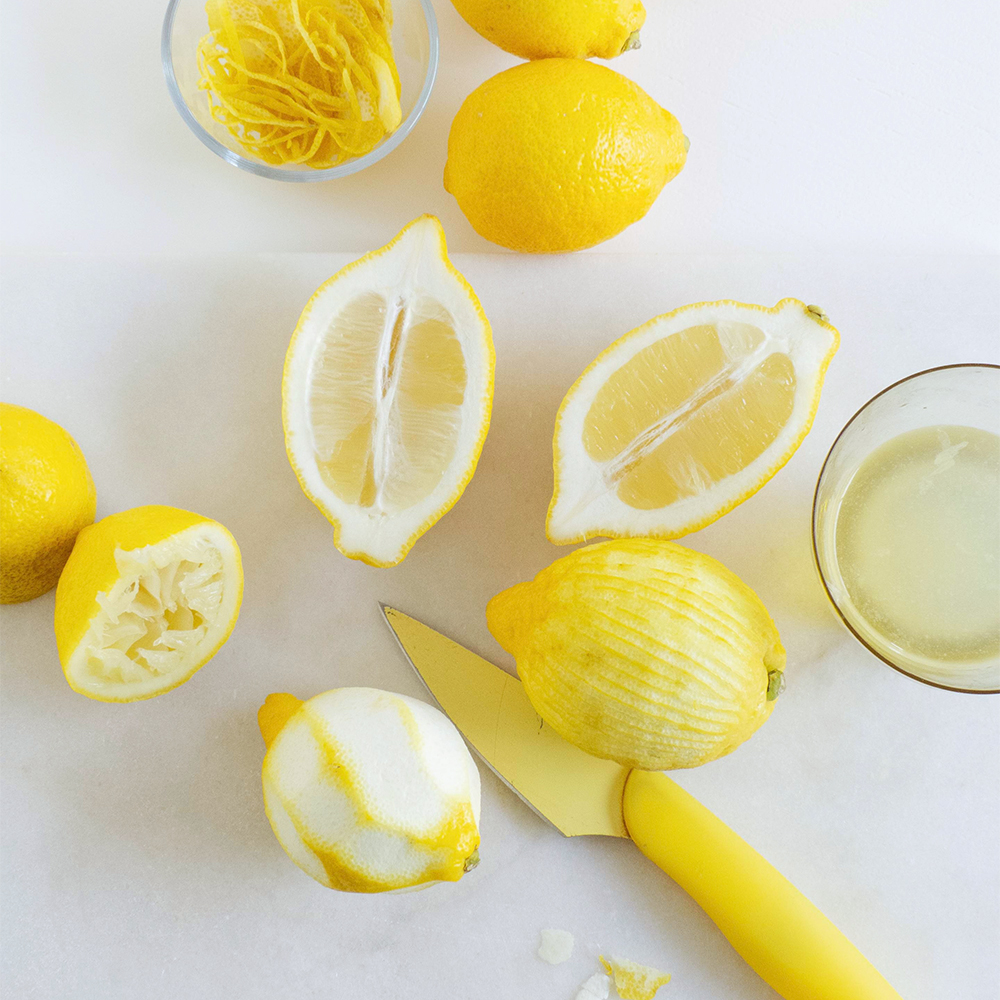 The fiber in citrus is important, too! Most citrus fruits are rich in the fibers pectin, cellulose, lignin, and hemicellulose, which have benefits ranging from improved digestion to cholesterol reduction (and in some cases, serve as fermentable prebiotics for our gut bacteria; see also What Is the Gut Microbiome? And Why Should We Care About It? and The Fiber Manifesto-Part 2 of 5: The Many Types of Fiber). Citrus pectin, in particular, has exciting potential for our health. Pectin is soluble in water and is highly fermentable (meaning very little passes through to the colon, since it’s is so readily fermented by bacteria in the small intestine). Pectins are rich in galacturonic acid and can be found in several types of configurations (further subdividing this class of fibers by structure). Some research indicates that citrus pectin can support weight loss, and this fiber has been shown to inhibit the binding of fibroblast growth factor (FGF) with the FGF receptor, in turn potentially affecting cholesterol metabolism. In vitro studies have shown that pectins may have a role in cancer protection and treatment due to their ability to reduce metastasis, angiogenesis, and solid tumor growth.
The fiber in citrus is important, too! Most citrus fruits are rich in the fibers pectin, cellulose, lignin, and hemicellulose, which have benefits ranging from improved digestion to cholesterol reduction (and in some cases, serve as fermentable prebiotics for our gut bacteria; see also What Is the Gut Microbiome? And Why Should We Care About It? and The Fiber Manifesto-Part 2 of 5: The Many Types of Fiber). Citrus pectin, in particular, has exciting potential for our health. Pectin is soluble in water and is highly fermentable (meaning very little passes through to the colon, since it’s is so readily fermented by bacteria in the small intestine). Pectins are rich in galacturonic acid and can be found in several types of configurations (further subdividing this class of fibers by structure). Some research indicates that citrus pectin can support weight loss, and this fiber has been shown to inhibit the binding of fibroblast growth factor (FGF) with the FGF receptor, in turn potentially affecting cholesterol metabolism. In vitro studies have shown that pectins may have a role in cancer protection and treatment due to their ability to reduce metastasis, angiogenesis, and solid tumor growth.
When it comes to supporting our gut health, citrus is a particularly worthy addition to our diet. Pectin from lemon has been shown to stimulate the bacteria Ruminococcaceae and Succinivibrionaceae, which in turn produce butyrate that our intestinal cells use for fuel (and which exert important anti-cancer effects). The citrus phytochemicals naringin and hesperidin appear to stimulate short-chain fatty acid production and enhance the growth of Bifidobacterium bifidum, Bifidobacterium adolescentis, and the Clostridium coccoides/Eubacterium rectale cluster.
In another study, 500 mg of citrus extract (containing at least 80% hesperidin-2S and at least 4% naringin) significantly increased the relative abundance of the Clostridium coccoides/Eubacterium rectale cluster while also increasing levels of butyrate and total SCFAs.
Likewise, orange juice can enhance short-chain fatty acid production and stimulate the growth of important probiotics such as Lactobacillus and Bifidobacterium, while decreasing enterobacteria. A controlled clinical study of 10 healthy women found that daily orange juice consumption increased fecal levels of Bifidobacterium and Lactobacillus species, while also increasing the production of SCFAs. Similarly, juice from two different orange varieties (Cara Cara and Bahia) increased the abundance of some potentially beneficial Clostridium members, while the Cara Cara juice led to a more significant increase in certain metabolites (such as inositol, choline, lysine, arginine, urocanic acid, and formate)—suggesting that even varieties within a single citrus species may have different benefits for us. (Once again, variety is key!)
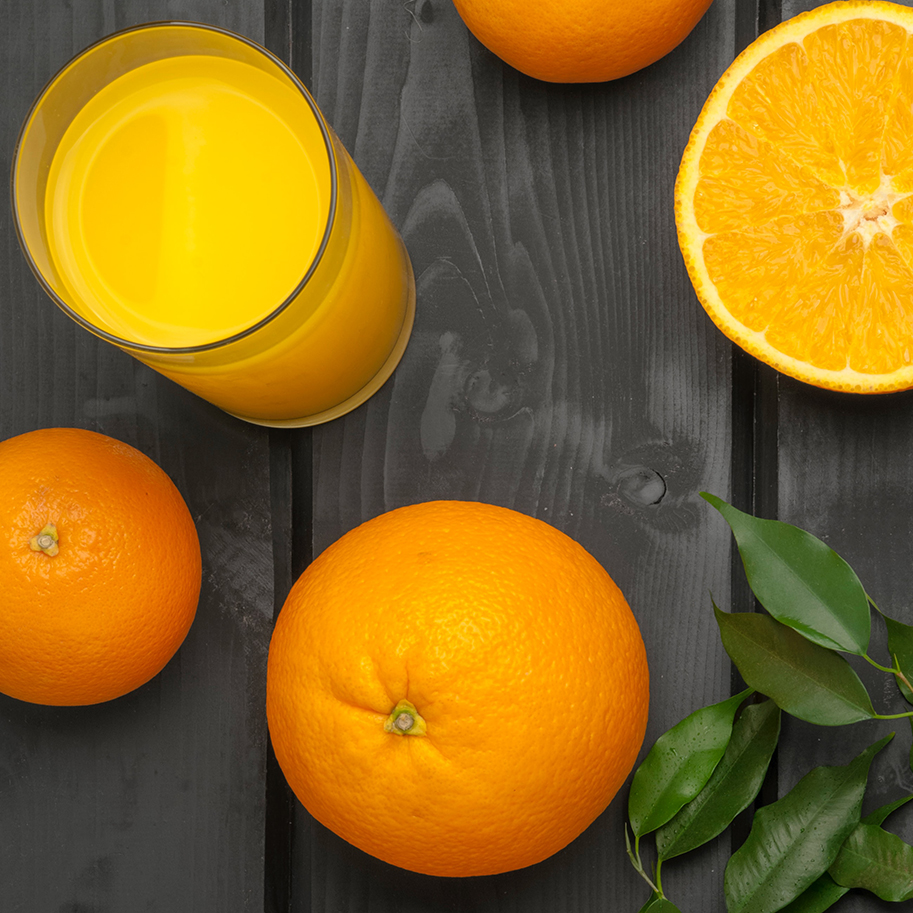 Citrus Juice vs. Whole Fruit
Citrus Juice vs. Whole Fruit
Although juice delivers some of the good stuff citrus contains, eating the whole fruit is really where it’s at! One study examined the bioactive compound content and antioxidant capacity of different parts of citrus fruits—the juice sacs, the segment membranes, and the segments—and found that the concentration of phenolic compounds and total antioxidant capacity were highest in the segment membranes, which get removed during juicing. Likewise, in nearly all citrus fruits, very high concentrations of phenolic compounds exist in the albedo—the white spongy layer between the fruit segments and the outer skin. Although this part of the citrus fruit isn’t necessarily the tastiest to eat, adding some of it to a smoothie or other recipe can help mask the flavor and deliver a major phytochemical punch! See also Celery Juice: Fad or Fabulous? and Move Over, Smoothies and Juice? The Soup-rising Benefits of Souping!
Grapefruit and Drug Interactions
The only contraindication on the citrus front is with grapefruit. Although grapefruit is perfectly healthy for most people, it contains high levels of furanocoumarins—compounds that interfere with the cytochrome P450 superfamily of liver enzymes, and as a result, create potentially harmful drug interactions. More specifically, furanocoumarins get metabolized by the enzyme CYP3A4 and then bond the active site of the enzyme, inactivating it. When CYP3A4 activity gets impaired, the body no longer metabolizes many drugs as expected—including many statins, calcium channel blockers, loratadine (Claritin), clarithromycin, certain pain medications, and some immunosuppressants. As a result, blood levels of these drugs can rise (if the drug requires liver enzymes to become inactivated), resulting in more severe side effects or even brand new side effects, or blood levels of the drugs can fall (if the drug requires liver enzymes to become an active metabolite), resulting in a loss of the therapeutic effect. In either case, the consequence can be dangerous! In all, over 85 medications are either known or predicted to interact with grapefruit, and eating just a single whole grapefruit or drinking 200 mL of grapefruit juice can be enough to cause drug overdose toxicity. Moral of the story, we should make sure to double-check any prescriptions for interactions before we enjoy our grapefruit!
In all, citrus makes a wonderful addition to our menu: their low energy density and high micronutrient and phytochemical content can improve our overall diet quality, and their array of phytonutrients supports our health through a wide range of mechanisms.
Citations
Abeysinghe DC, et al. “Bioactive compounds and antioxidant capacities in different edible tissues of citrus fruit of four species.” Food Chemistry 2007;104(4):1338-1344.
Bailey DG, et al. “Grapefruit-medication interactions: forbidden fruit or avoidable consequences?” CMAJ. 2013 Mar 5;185(4):309-16. doi: 10.1503/cmaj.120951. Epub 2012 Nov 26.
Bianchi F, et al. “Modulation of gut microbiota from obese individuals by in vitro fermentation of citrus pectin in combination with Bifidobacterium longum BB-46.” Appl Microbiol Biotechnol. 2018 Oct;102(20):8827-8840. doi: 10.1007/s00253-018-9234-8. Epub 2018 Aug 18.
Brasili E, et al. “Daily Consumption of Orange Juice from Citrus sinensis L. Osbeck cv. Cara Cara and cv. Bahia Differently Affects Gut Microbiota Profiling as Unveiled by an Integrated Meta-Omics Approach.” J Agric Food Chem. 2019 Feb 6;67(5):1381-1391. doi: 10.1021/acs.jafc.8b05408. Epub 2019 Jan 25.
Gorinstein S, et al. “Red grapefruit positively influences serum triglyceride level in patients suffering from coronary atherosclerosis: studies in vitro and in humans.” J Agric Food Chem. 2006 Mar 8;54(5):1887-92.
Gualdani R, et al. “The Chemistry and Pharmacology of Citrus Limonoids.” Molecules. 2016 Nov 13;21(11). pii: E1530.
Lima ACD, et al. “Effect of Daily Consumption of Orange Juice on the Levels of Blood Glucose, Lipids, and Gut Microbiota Metabolites: Controlled Clinical Trials.” J Med Food. 2019 Feb;22(2):202-210. doi: 10.1089/jmf.2018.0080. Epub 2019 Jan 14.
Mahmoud AM, et al. “Beneficial Effects of Citrus Flavonoids on Cardiovascular and Metabolic Health.” Oxid Med Cell Longev. 2019 Mar 10;2019:5484138. doi: 10.1155/2019/5484138. eCollection 2019.
Patil BS, et al. “Potential Health Benefits of Citrus: An Overview.” ACS Symposium Series 2006;936:1-16.
Schutte AE. “Fruit intake and reduced risk of hypertension: are there any forbidden fruits?” Eur J Prev Cardiol. 2020 Jan;27(1):36-38. doi: 10.1177/2047487319876767. Epub 2019 Oct 18.
Stevens Y, et al. “The Intestinal Fate of Citrus Flavanones and Their Effects on Gastrointestinal Health.” Nutrients. 2019 Jul; 11(7): 1464.
Yamada T, et al. “Frequency of citrus fruit intake is associated with the incidence of cardiovascular disease: the Jichi Medical School cohort study.” J Epidemiol. 2011;21(3):169-75. Epub 2011 Mar 5.

